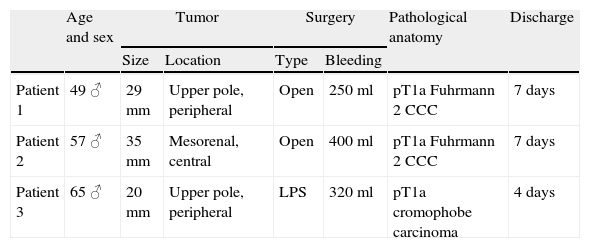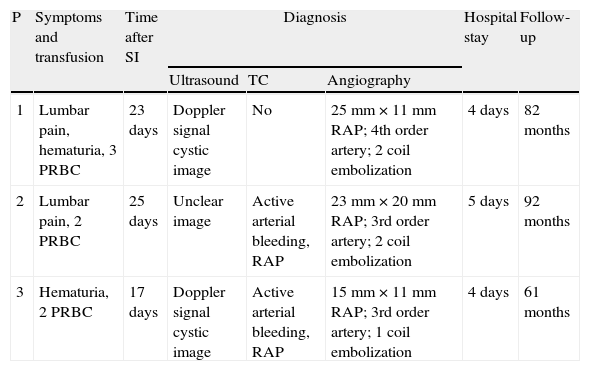Bleeding after partial nephrectomy can be immediate or delayed and may have severe consequences. The incidence of this complication is low. The most frequent cause of delayed bleeding is arterial pseudoaneurysm. Superselective embolization is a feasible therapeutic option that has shown good results.
ObjectiveTo evaluate treatment and outcomes of delayed bleeding in our series of patients with partial nephrectomy.
Material and methodsWe performed a retrospective study of our database of partial nephrectomies. Patients who developed delayed bleeding (after discharge) were identified. Clinical histories were reviewed and data on presentation, diagnosis, treatment and outcomes were analyzed.
ResultsAmong our series of patients undergoing partial nephrectomy, three developed delayed bleeding (1.3%). Symptom onset occurred 17–25 days after surgery and consisted of hematuria or lumbar pain. Diagnosis was provided through ultrasound, abdominal computed tomography and renal angiography. In all three patients, a complicated pseudoaneurysm was diagnosed and all patients underwent renal artery catheterization with selective renal artery embolization. In all patients, immediate control of bleeding was achieved. Outcome after a follow-up of 61–92 months was favorable.
ConclusionsSelective vascular embolization is the treatment of choice of renal pseudoaneurysm after partial nephrectomy in hemodynamically stable patients.
El sangrado después de una nefrectomía parcial es una complicación con posibles consecuencias graves. Puede ser inmediato o diferido y su incidencia es baja. La causa más frecuente del sangrado diferido es el pseudoaneurisma arterial. La embolización supraselectiva vascular es una opción terapéutica posible que ha demostrado buenos resultados.
ObjetivoEvaluar la evolución y el tratamiento del sangrado diferido en nuestra serie de pacientes con nefrectomías parciales.
Material y métodosRealizamos un estudio retrospectivo de nuestra base de datos de nefrectomías parciales. Identificamos los pacientes que presentaron sangrado diferido (después del alta). Se revisó la historia clínica, analizando datos sobre la presentación, el diagnóstico, el tratamiento y la evolución de los pacientes.
ResultadosDe nuestra serie de nefrectomías parciales tres pacientes presentaron sangrado diferido (1,3%). La clínica se inició después de 17 a 25 días de la cirugía por la aparición de hematuria o dolor lumbar. El diagnóstico se realizó mediante ecografía, TAC abdominal y angiografía renal. En todos los pacientes se diagnosticó un pseudoaneurisma arterial complicado, siendo sometidos a cateterismo arterial renal con embolización selectiva del mismo. La evolución fue correcta en todos los pacientes con control inmediato del sangrado. Documentamos un seguimiento posterior favorable de 61 a 92 meses.
ConclusionesLa embolización selectiva vascular es el tratamiento de elección del pseudoaneurisma renal sintomático después de nefrectomía parcial en el paciente hemodinámicamente estable.










